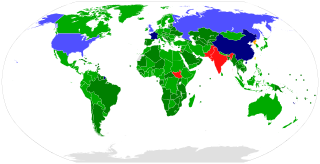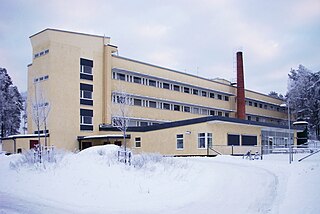
The Treaty on the Non-Proliferation of Nuclear Weapons, commonly known as the Non-Proliferation Treaty or NPT, is an international treaty whose objective is to prevent the spread of nuclear weapons and weapons technology, to promote cooperation in the peaceful uses of nuclear energy, and to further the goal of achieving nuclear disarmament and general and complete disarmament. Between 1965 and 1968, the treaty was negotiated by the Eighteen Nation Committee on Disarmament, a United Nations-sponsored organization based in Geneva, Switzerland.

Nuclear proliferation is the spread of nuclear weapons, fissionable material, and weapons-applicable nuclear technology and information to nations not recognized as "Nuclear Weapon States" by the Treaty on the Non-Proliferation of Nuclear Weapons, commonly known as the Non-Proliferation Treaty or NPT. Proliferation has been opposed by many nations with and without nuclear weapons, as governments fear that more countries with nuclear weapons will increase the possibility of nuclear warfare, de-stabilize international or regional relations, or infringe upon the national sovereignty of nation states.
The nuclear program of Iran has included several research sites, two uranium mines, a research reactor, and uranium processing facilities that include three known uranium enrichment plants. In 1970, Iran ratified the Non-Proliferation Treaty (NPT), making its nuclear program subject to the IAEA's verification.

In the 1970s and 1980s, during the military regime, Brazil had a secret program intended to develop nuclear weapons. The program was dismantled in 1990, five years after the military regime ended, and Brazil is considered free of weapons of mass destruction.

Rosatom, stylized as ROSATOM and also known as the Rosatom State Nuclear Energy Corporation, the State Atomic Energy Corporation Rosatom, or the Rosatom State Corporation, is a Russian state corporation headquartered in Moscow that specializes in nuclear energy. Established in 2007, the organization comprises more than 360 enterprises, including scientific research organizations, the nuclear weapons complex, and the world's only nuclear icebreaker fleet.

The 1958 US–UK Mutual Defense Agreement, or UK–US Mutual Defence Agreement, is a bilateral treaty between the United States and the United Kingdom on nuclear weapons co-operation. The treaty's full name is Agreement between the Government of the United States of America and the Government of the United Kingdom of Great Britain and Northern Ireland for Cooperation on the uses of Atomic Energy for Mutual Defense Purposes. It allows the US and the UK to exchange nuclear materials, technology and information. The US has nuclear co-operation agreements with other countries, including France and other NATO countries, but this agreement is by far the most comprehensive. Because of the agreement's strategic value to Britain, Harold Macmillan called it "the Great Prize".
The Megatons to Megawatts Program, successfully completed in December 2013, is the popular name given to the program which is also called the United States-Russia Highly Enriched Uranium Purchase Agreement. The official name of the program is the "Agreement between the Government of the Russian Federation and the Government of the United States of America Concerning the Disposition of Highly-Enriched Uranium Extracted from Nuclear Weapons", dated February 18, 1993. Under this Agreement, Russia agreed to supply the United States with low-enriched uranium (LEU) obtained from high-enriched uranium (HEU) found to be in excess of Russian defense purposes. The United States agreed to purchase the low-enriched uranium fuel.

North Korea (DPRK) has been active in developing nuclear technology since the 1950s.

The program for nuclear power in Indonesia includes plans to build nuclear reactors in the country for peaceful purposes. The national legislative organ for nuclear energy, Badan Pengawas Tenaga Nuklir (BAPETEN), was founded in 1998. The national agency for atomic energy is BATAN.
This is the timeline of the nuclear program of Iran.

Nuclear power is the fifth-largest source of electricity in India after coal, gas, hydroelectricity and wind power. As of November 2020, India has 23 nuclear reactors in operation in 7 nuclear power plants, with a total installed capacity of 7,480 MW. Nuclear power produced a total of 43 TWh in 2020-21, contributing 3.11% of total power generation in India. 10 more reactors are under construction with a combined generation capacity of 8,000 MW.

Russia–Venezuela relations include cooperation between Russia and Venezuela in areas of common concern, such as their common status as oil exporters, and policy toward the United States. Venezuela is Russia's most important trading and military ally in Latin America. Russia recognizes Nicolás Maduro as the president of Venezuela, instead of Juan Guaidó, in the Venezuelan presidential crisis.
President Adly Mansour announced on 7 November 2013 that Egypt was restarting its nuclear power program in El Dabaa; a deal was reached with the residents in which it was agreed that a residential area will also be built. The Egyptian minister of electricity, Ahmed Emam, has called the project "necessary" because of a small amount of renewable energy sources and not enough fuel.
This timeline of nuclear weapons development is a chronological catalog of the evolution of nuclear weapons rooting from the development of the science surrounding nuclear fission and nuclear fusion. In addition to the scientific advancements, this timeline also includes several political events relating to the development of nuclear weapons. The availability of intelligence on recent advancements in nuclear weapons of several major countries is limited because of the classification of technical knowledge of nuclear weapons development.

Mexico is one of the few countries which has technical capabilities to manufacture nuclear weapons. However it has renounced them and pledged to only use its nuclear technology for peaceful purposes following the Treaty of Tlatelolco in 1968. In the 1970s Mexico's national institute for nuclear research successfully achieved the creation of highly enriched uranium which is used in nuclear power plants and in the construction of nuclear weapons. However the country agreed in 2012 to downgrade the high enriched uranium used on its nuclear power plants to low enriched uranium, the process was realised with the assistance of the International Atomic Energy Agency. It is unknown if Mexico ever created or possessed nuclear or any other kind of mass destruction weapons.

In Argentina, about 10% of the electricity comes from 3 operational nuclear reactors: The Embalse Nuclear Power Station, a CANDU reactor, and the Atucha 1 plant in 1974, a PHWR German design. In 2001, the plant was modified to burn Slightly Enriched Uranium, making it the first PHWR reactor to burn that fuel worldwide. Atucha was originally planned to be a complex with various reactors. Atucha 2 began to produce energy on June 3, 2014, and it is expected to produce 745MWh. Plans for Atucha III, a third reactor in the Atucha complex, have been announced.

After World War II, Sweden considered building nuclear weapons to defend themselves against an offensive assault from the Soviet Union. From 1945 to 1972 the government ran a clandestine nuclear weapons program under the guise of civilian defense research at the Swedish National Defence Research Institute (FOA).

Switzerland made detailed plans to acquire and test nuclear weapons during the Cold War. Less than two weeks after the nuclear bombings of Hiroshima and Nagasaki, the Swiss government started studying the possibility of building nuclear weapons, and continued its military nuclear program for 43 years until 1988. It has since signed and ratified the Treaty on the Non-Proliferation of Nuclear Weapons. Switzerland never possessed biological weapons, but did have a program of the Swiss Army high command to develop and test chemical weapons.

Saudi Arabia has not officially maintained and possessed weapons of mass destruction (WMD). In 1972 Saudi Arabia signed and approved the convention on the prohibition of the development, production and stockpiling of biological (bacteriological) and toxin weapons. Nevertheless, Saudi Arabia has made steps towards a nuclear program and according to some observations, they can be used to develop nuclear weapons. According to some reports, Riyadh has an alleged deal with Pakistan regarding nuclear weapons projects.

The RV-1 nuclear reactor, now repurposed and known as Gamma rays sterilization plant, is a facility located in Altos Mirandinos, Miranda, Venezuela. It was the only nuclear reactor in Venezuela and one of the first reactors in Latin America. Currently, it is used as a gamma ray facility for microbiological sterilization of surgical supplies, packaging, medicine and dry food.














